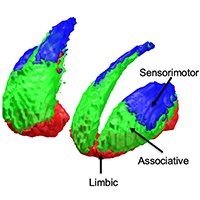Striatal topographical organization: Bridging the gap between molecules, connectivity and behavior

Accepted: 7 September 2021
HTML: 16
All claims expressed in this article are solely those of the authors and do not necessarily represent those of their affiliated organizations, or those of the publisher, the editors and the reviewers. Any product that may be evaluated in this article or claim that may be made by its manufacturer is not guaranteed or endorsed by the publisher.
Authors
The striatum represents the major hub of the basal ganglia, receiving projections from the entire cerebral cortex and it is assumed to play a key role in a wide array of complex behavioral tasks. Despite being extensively investigated during the last decades, the topographical organization of the striatum is not well understood yet. Ongoing efforts in neuroscience are focused on analyzing striatal anatomy at different spatial scales, to understand how structure relates to function and how derangements of this organization are involved in various neuropsychiatric diseases. While being subdivided at the macroscale level into dorsal and ventral divisions, at a mesoscale level the striatum represents an anatomical continuum sharing the same cellular makeup. At the same time, it is now increasingly ascertained that different striatal compartments show subtle histochemical differences, and their neurons exhibit peculiar patterns of gene expression, supporting functional diversity across the whole basal ganglia circuitry. Such diversity is further supported by afferent connections which are heterogenous both anatomically, as they originate from distributed cortical areas and subcortical structures, and biochemically, as they involve a variety of neurotransmitters. Specifically, the cortico-striatal projection system is topographically organized delineating a functional organization which is maintained throughout the basal ganglia, subserving motor, cognitive and affective behavioral functions. While such functional heterogeneity has been firstly conceptualized as a tripartite organization, with sharply defined limbic, associative and sensorimotor territories within the striatum, it has been proposed that such territories are more likely to fade into one another, delineating a gradient-like organization along medio-lateral and ventro-dorsal axes. However, the molecular and cellular underpinnings of such organization are less understood, and their relations to behavior remains an open question, especially in humans. In this review we aimed at summarizing the available knowledge on striatal organization, especially focusing on how it links structure to function and its alterations in neuropsychiatric diseases. We examined studies conducted on different species, covering a wide array of different methodologies: from tract-tracing and immunohistochemistry to neuroimaging and transcriptomic experiments, aimed at bridging the gap between macroscopic and molecular levels.
How to Cite

This work is licensed under a Creative Commons Attribution-NonCommercial 4.0 International License.
PAGEPress has chosen to apply the Creative Commons Attribution NonCommercial 4.0 International License (CC BY-NC 4.0) to all manuscripts to be published.
Similar Articles
- L Pilloni, P Bianco, C Manieli, G Senes, P Coni, L Atzori, N Aste, G Faa, Immunoreactivity for alpha-smooth muscle actin characterizes a potentially aggressive subgroup of little basal cell carcinomas , European Journal of Histochemistry: Vol. 53 No. 2 (2009)
- A. Sbarbati, D. Accorsi, D. Benati, L. Marchetti, G. Orsini, G. Rigotti, P. Panettiere, Subcutaneous adipose tissue classification , European Journal of Histochemistry: Vol. 54 No. 4 (2010)
- T. Cobo, A. Obaya, S. Cal, L. Solares, R. Cabo, J.A. Vega, J. Cobo, Immunohistochemical localization of periostin in human gingiva , European Journal of Histochemistry: Vol. 59 No. 3 (2015)
- C. Pellicciari, Histochemistry through the years, browsing a long-established journal: novelties in traditional subjects , European Journal of Histochemistry: Vol. 54 No. 4 (2010)
- Y. Zhu, D. Ning, F. Wang, C. Liu, Y. Xu, X. Jia, D. Zhu, Effect of thyroxine on munc-18 and syntaxin-1 expression in dorsal hippocampus of adult-onset hypothyroid rats , European Journal of Histochemistry: Vol. 56 No. 2 (2012)
- Y.F. Costa, K.C. Tjioe, S. Nonogaki, F.A. Soares, J.R. Pereira Lauris, D. Tostes Oliveira, Are podoplanin and ezrin involved in the invasion process of the ameloblastomas? , European Journal of Histochemistry: Vol. 59 No. 1 (2015)
- K.R. Torres-da-Silva, A.V. da Silva, N.O. Barioni, G.W.L. Tessarin, J.A. de Oliveira, E. Ervolino, J.A.C. Horta-Junior, C.A. Casatti, Neurochemistry study of spinal cord in non-human primate (Sapajus spp.) , European Journal of Histochemistry: Vol. 60 No. 3 (2016)
- D. Michalski, M. Heindl, J. Kacza, F. Laignel, L. Küppers-Tiedt, D. Schneider, J. Grosche, J. Boltze, M. Löhr, C. Hobohm, W. Härtig, Spatio-temporal course of macrophage-like cell accumulation after experimental embolic stroke depending on treatment with tissue plasminogen activator and its combination with hyperbaric oxygenation , European Journal of Histochemistry: Vol. 56 No. 2 (2012)
- Arianna Casini, Giorgio Vivacqua, Rosa Vaccaro, Anastasia Renzi, Stefano Leone, Luigi Pannarale, Antonio Franchitto, Paolo Onori, Romina Mancinelli, Eugenio Gaudio, Expression and role of cocaine-amphetamine regulated transcript (CART) in the proliferation of biliary epithelium , European Journal of Histochemistry: Vol. 67 No. 4 (2023)
- S. Soddu, E. Di Felice, S. Cabras, M.E. Castellanos, L. Atzori, G. Faa, L. Pilloni, IMP-3 expression in keratoacanthomas and squamous cell carcinomas of the skin: an immunohistochemical study , European Journal of Histochemistry: Vol. 57 No. 1 (2013)
<< < 1 2 3 4 5 6 7 8 9 10 > >>
You may also start an advanced similarity search for this article.

 https://doi.org/10.4081/ejh.2021.3284
https://doi.org/10.4081/ejh.2021.3284










